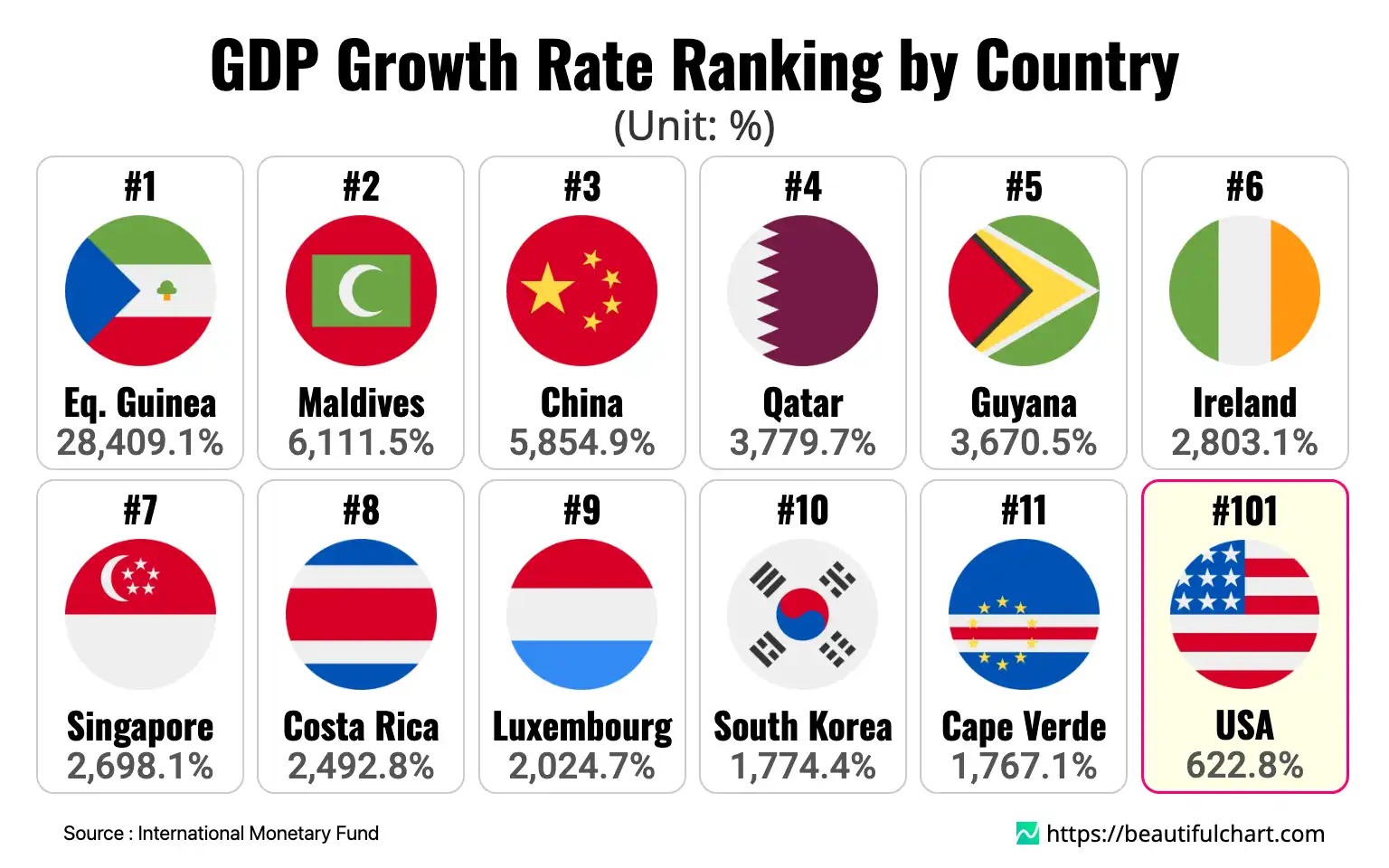A review of economic data from the past four decades reveals Equatorial Guinea as the global leader in GDP growth, with an astonishing 28,409.1% increase. Following are nations like the Maldives and China, which also demonstrated remarkable economic expansion, showcasing different paths to prosperity through tourism and industrialization, respectively. In contrast, established economies like the United States grew at a more moderate pace, highlighting the dramatic shifts in the global economic landscape between 1984 and 2024.

Gross Domestic Product (GDP) represents the total monetary or market value of all the finished goods and services produced within a country's borders in a specific time period. As a broad measure of overall domestic production, it functions as a comprehensive scorecard of a given country’s economic health. It is the most common indicator used to track the health and size of an economy.
A Four-Decade Review of Global Economic Expansion
Over the past forty years, the world has witnessed unprecedented economic transformations, with several nations experiencing explosive expansion that has reshaped their societies and their roles on the global stage. This period has been characterized by globalization, technological advancement, and significant geopolitical shifts, creating opportunities for rapid development in various regions. The drivers behind these success stories are diverse, ranging from the discovery of vast natural resources to strategic industrial policies and the cultivation of high-value service sectors.
The Outliers: Resource-Driven Growth
The most dramatic stories of economic expansion often involve the discovery and exploitation of valuable natural resources. Equatorial Guinea stands as the most extreme example, with its economy catapulted by the discovery of large oil reserves in the 1990s. This influx of oil revenue led to massive investments in infrastructure and a staggering increase in its national output. Similarly, Guyana has recently emerged as a growth leader due to major offshore oil discoveries, positioning it for a period of rapid economic development. In the Middle East, Qatar's immense wealth from natural gas has fueled its growth, allowing it to become one of the world's richest countries per capita and a major player in global finance and aviation.
The Asian Tigers and Beyond: Manufacturing and Tourism
Beyond resource wealth, strategic economic planning has been a powerful engine of growth, particularly in Asia. China's journey is a primary example; its transition to a market-oriented economy, coupled with its focus on becoming the world's manufacturing hub, has lifted hundreds of millions out of poverty and resulted in sustained, high-speed expansion for decades. The Maldives represents another model, having successfully built a world-class luxury tourism industry that has transformed its economy from one based on fishing to a high-income service-based system. These cases demonstrate how targeted policies and leveraging unique national advantages can create powerful and lasting economic momentum.
Stable Expansion in Developed Economies
In contrast to the explosive figures seen in emerging markets, the world's largest developed economies, such as the United States, have experienced more moderate and stable growth. The U.S. economy expanded by 622.8% over the same 40-year period. While this percentage is significantly lower than that of the top-ranked countries, it represents substantial growth from a much larger initial economic base. The U.S. expansion has been driven by innovation in technology, a dominant service sector, and its position as a global financial center. This highlights a common economic principle: it is far more challenging for large, mature economies to achieve the percentage growth rates seen in smaller, developing nations that are starting from a lower baseline.
Key Takeaways
Key Drivers of Economic Transformation
- The discovery of significant natural resources, particularly oil and gas, has been a primary catalyst for the most extreme growth rates, as seen in Equatorial Guinea and Guyana.
- Strategic shifts in economic policy, such as China's move towards a market-oriented, manufacturing-based economy, have enabled decades of sustained high-speed expansion.
- The development of specialized, high-value industries like luxury tourism in the Maldives has proven to be a powerful engine for smaller nations.
Contrasting Growth Patterns
- Emerging economies have demonstrated the potential for explosive, triple or quadruple-digit percentage growth over a 40-year period, fundamentally reshaping their economic status.
- Developed nations like the United States show more moderate, yet substantial, growth in absolute terms, reflecting the maturity and large scale of their economies.
- The list of high-growth countries is geographically diverse, including nations from Africa, Asia, the Middle East, and South America, indicating that rapid development is a global phenomenon.
Top Ranking
#1 Eq. Guinea 28,409.1%
Equatorial Guinea's astronomical GDP growth is one of the most dramatic economic stories of the modern era. This Central African nation was one of the poorest countries in the region until the discovery of large offshore oil reserves in the mid-1990s. The subsequent boom in oil production transformed its economy, leading to a massive influx of foreign investment and revenue. This has funded significant infrastructure projects, including new roads, ports, and government buildings, but the wealth distribution remains highly unequal.
#2 Maldives 6,111.5%
The Maldives has engineered a remarkable economic expansion by transforming itself into a world-renowned luxury tourism destination. Over the past four decades, the island nation has leveraged its pristine natural beauty—coral reefs, white sandy beaches, and clear blue waters—to attract high-spending tourists. This focus on high-end resorts and exclusive travel experiences has created a powerful service-based economy, moving it far beyond its previous reliance on fishing and generating substantial national income.
#3 China 5,854.9%
China's staggering growth is a result of historic economic reforms that began in the late 1970s and accelerated over the following decades. By embracing market-oriented policies, opening up to foreign trade and investment, and establishing itself as the 'world's factory,' China became a global manufacturing powerhouse. This strategy lifted hundreds of millions of its citizens out of poverty, fueled massive urbanization, and turned the nation into the world's second-largest economy, fundamentally altering the global economic balance.
#4 Qatar 3,779.7%
Qatar's immense economic growth has been fueled almost entirely by its vast reserves of natural gas, the third-largest in the world. By heavily investing in the extraction and export of liquefied natural gas (LNG), the small Gulf nation transformed itself into one of the richest countries in the world on a per capita basis. This wealth has been used to fund massive infrastructure projects, develop a world-class airline, and diversify its economy into finance, real estate, and international investments.
#5 Guyana 3,670.5%
Guyana's recent surge in GDP growth is a direct result of the discovery of massive offshore oil reserves, which began production in 2019. This South American nation is now one of the world's fastest-growing economies, with oil revenues projected to transform its public finances and development prospects. The influx of wealth presents a monumental opportunity for infrastructure, education, and healthcare improvements, positioning Guyana as a new major player in the global energy market.
#101 USA 622.8%
The United States, as one of the world's largest and most developed economies, recorded a growth of 622.8% over the past 40 years. While this percentage is modest compared to the top-ranked emerging nations, it represents significant and stable expansion from a very high baseline. U.S. growth has been driven by technological innovation, particularly in Silicon Valley, a dominant global position in finance and services, and strong consumer spending. Its mature economy continues to be a primary engine of global economic activity.
| Rank | Name | Indicator | Subindicator |
|---|---|---|---|
1 | 28,409.1% | 1984 : $ 44M | |
2 | 6,111.5% | 1984 : $ 113M | |
3 | 5,854.9% | 1984 : $ 314B | |
4 | 3,779.7% | 1984 : $ 5.7B | |
5 | 3,670.5% | 1984 : $ 654M | |
6 | 2,803.1% | 1984 : $ 19.8B | |
7 | 2,698.1% | 1984 : $ 19.5B | |
8 | 2,492.8% | 1984 : $ 3.6B | |
9 | 2,024.7% | 1984 : $ 4.3B | |
10 | 1,774.4% | 1984 : $ 99.7B | |
11 | 1,767.1% | 1984 : $ 146M | |
12 | 1,745.3% | 1984 : $ 211B | |
13 | 1,740.5% | 1984 : $ 168M | |
14 | 1,697.7% | 1984 : $ 30B | |
15 | 1,608.9% | 1984 : $ 8.3B | |
16 | 1,582.1% | 1984 : $ 26.8B | |
17 | 1,531.0% | 1984 : $ 20.2B | |
18 | 1,520.9% | 1984 : $ 1.1B | |
19 | 1,513.0% | 1984 : $ 1.2B | |
20 | 1,504.8% | 1984 : $ 1.4B |





